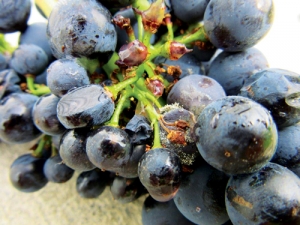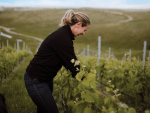Editorial: What is driving research in NZ?
OPINION: The politics of science or is it the science of politics that is driving research in New Zealand?
 Botrytis starting in the centre of the bunch around floral trash. Shaking the vine removes the trash, and the disease threat.
Botrytis starting in the centre of the bunch around floral trash. Shaking the vine removes the trash, and the disease threat.
It was the trial very few wanted to take part in – although given the results - more may have wished they had done so.
The trial was to determine if mechanical shaking, not to be confused with mechanical thinning, would lead to less incidence of botrytis.
For the past four years, trials undertaken in Marlborough and Hawke’s Bay have highlighted the fact that not only does mechanical thinning lower yields, but interestingly, also lowers levels of botrytis.
Marlborough viticultural consultant Mark Allen has been involved as project manager in the previous four years of trials (funded by NZW, MPI and conducted by Plant and Food), and after completion of the trials last year, this year wanted to take them a little further.
He wanted to know if you shook a vine at a ‘light’ harvester setting and removed floral trash without dropping yield, would the botrytis levels also drop accordingly. Part of Dion Mundy’s work in the original trials did show that there was a strong correlation between the amount of residual trash left in the bunch and the degree of botrytis severity.
However convincing growers to take part in the trial was a hard task, Allen admits, especially given the smaller crops this year.
“The perception for many was, that if you shake the vine, you will reduce crop,” Allen says. “My intention this year, despite the potentially lower cropping levels which could still be susceptible to botrytis, was to see if a ‘light’ shake could have the same positive impact on botrytis without reducing yields”
The 2015 vintage will be remembered for being hot and dry – during the early months of this year at least. Allen says that was another reason growers weren’t considering botrytis levels very seriously when he was looking for trial blocks. The reality though was when it came close to harvest, many vineyards throughout the country were faced with considerable botrytis pressure.
“This I suspect was a result of rain events leading up to harvest, but also a result of the high levels of floral trash that remained in the bunch after the cool flowering conditions.”
With 40 sites spread from Marlborough to Central Otago, he trialed the shaking method on five varieties; Sauvignon Blanc, Chardonnay, Riesling, Pinot Gris and Pinot Noir.
“Over the four years of the trials we have become very familiar with the various harvester settings that can control the degree of thinning desired. When yield reduction is required, we know that we will see damage to the berries and bunches. This year I set the harvesters up so that there was no physical damage to berries or bunches.”
Three harvesters were used, a Pellenc, a Gregoire 125 and a Gregoire Tow Behind.
Allen says the harvesters were set up with two rods, one aimed at the trunk, the other set 50mm above the fruiting zone. The ground speed was between 5kph and 5.5kph,with the beater speed between 480 and 490.
In no situation was crop dropped, only trash, and while there were signs of immediate trauma to the growing tips (as occurred in all the mechanical thinning trials), at harvest Allen could not detect any reduction in berry size or bunch weight, delay in ripening or change in harvest brix levels.

Botrytis Levels
The overall result of the trial showed that shaking the vine and removing the trash resulted in at least a 50 percent reduction in botrytis levels when compared with the Controls. In some cases the reduction was as high as 83 percent. The Controls applied a standard SWNZ MRL botryside programme at flowering, bunch closure and in some cases at veraison.
Right shows just some of the results. Note the high level of botrytis incidence in the old Sauvignon Blanc vines – 12.6, dropping to 2.2% after the vines were shaken.
A similar effect was seen in the Waipara Chardonnay, dropping from a botrytis level of 13.6 in the control vines, to just 3.6 in the shaken. In both cases, it is likely the grower would have been penalized in terms of payment, because of such high botrytis levels.
(At the time of writing the Central Otago results were yet to be confirmed).
In the photo below, there are 20 Sauvignon Blanc bunches taken prior to harvest, from both the control vines (left) and the shaken vines (right).
Of the 20 bunches in the Control sample, only three had no botrytis infection, compared with 11 uninfected bunches from the vine that was shaken.
Compare the levels of infection between the two samples – it is higher in the Control.
“There is also a noticeable hardening of the skins, which comes after shaking the vines, which could also play a part in the lower botrytis levels. Both Damian Martin and Mike Trought believe that the trauma caused by shaking the vine needs to be investigated further,” Allen says.
While the results are clearly apparent, Allen says there are still many growers who are reticent to undertake any form of shaking. He admits a lot of that is because they are afraid they will lose crop, (which he has shown doesn’t happen with a light shake), but they have other concerns as well.
“Many believe the costs are too high,” he says. “But the cost using a contract harvester worked out at $400 a hectare or 0.18c/vine, which roughly equates to just a quarter of a tonne per hectare of fruit at harvest.”
Compare that with what a botrytis infection would cost in terms of bunch thinning and fruit losses.
“Understandably there is also a feeling that mechanical shaking the vine is another job that needs to be done during what is already a very busy time of the year (January) with trimming, leaf plucking and spraying. But it only requires setting the harvester up for one run through, and you have achieved your result.”
Another point he says needs considering, is the fact this is an easy cultural control that involves no chemicals, or spraying regimes. Nor is it dependent upon chemical effectiveness, efficacy or timing. It also fits in well with Sustainable and Bio Grow objectives.

A few of the trial sites were run alongside Collard and other blowing options.
The outcome, as has been shown in the Plant and Food trials of the last two years, was that ‘shaking’ is considerably more effective at removing floral trash compared to blowing.
“Botrytis is the most significant limiting factor to cool climate grape growing. We have very few cultural opportunities to control it apart from leaf plucking and manipulating canopies. I believe that if growers can reduce the dependence of spraying options for botrytis, it could, as estimated in the Mechanical Thinning Trial save the industry overall $8 million. So the cost savings are starting to add up.”
And given the fact there is an increasing number of older harvesters sitting around the country, this is the perfect way of putting them to use. Imagine if you could set them up to shake the vines in January and at the same time provide harvester training to new drivers, prior to vintage occurring.
“If you are not reducing yields and not having to worry about how much crop is coming off, it is fairly basic driving –perfect for trainee drivers.”
But the most exciting aspect of these trials, which follow on from NZ Winegrower and Sustainable Farming Fund supported research on how to mechanically thin vines, is the fact we can reduce a devastating disease, with little or no impact on crop levels or quality.
“If for example a new botryside was released that showed the same results as a ‘light’ mechanical shake of at least a 50% reduction of botrytis infection, then I would be sure that the industry would adopt it very quickly. The outcome of what we are seeing with mechanical shaking is new to us all. For example, mechanical shaking is hardly mentioned in the 2013 publication of ‘Understanding Botrytis in New Zealand Vineyards’. The process and scientific understanding of mechanical shaking requires a different mindset. As commonly said – ‘it just doesn’t make sense to put a harvester through a vineyard at that time of year’. Whilst I can understand that, the reality and results of the last five years show that it does make sense.”
• For the full report on the Mechanical Thinning trials, and the resulting impact on botrytis levels, visit the NZWine members research pages.

OPINION: Harvest begins, and almost immediately we start to get media enquiries about how the vintage is going and whether it…

OPINION: Rachael Cook is the smiling grape grower on this month’s cover, tending vines on the miniscule, beautiful and dream-driven vineyard…
New Zealand wine enthusiasts have a deepening understanding and growing appreciation of sparkling wine, says Mel Skinner, Chair of Méthode Marlborough…
One of the biggest mistakes wine marketers make is in assuming consumers are as passionate and knowledgeable about wine as…
Taking two sustainability awards at two events on a single evening felt like "true recognition" of the work Lawson's Dry…